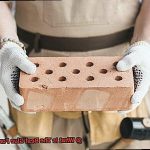When it comes to sticking concrete to concrete, finding the perfect glue is absolutely essential. Whether you’re tackling a big construction job or just fixing up some old concrete structures, using the right adhesive can mean the difference between success and failure. In this blog post, we’re going to explore the ultimate glue that can handle the tough task of bonding concrete.
One of the most reliable options for gluing concrete to concrete is epoxy adhesive. This stuff is like a superhero when it comes to bonding agents. It’s got incredible strength and durability, thanks to its two components – resin and hardener – that join forces and create a chemical reaction capable of forming an unbreakable bond in even the harshest environments.
The great thing about epoxy adhesive is its insane adhesive strength. It can create a bond that’s just as strong, if not stronger, than the very concrete it’s sticking together. And let me tell you, this stuff isn’t afraid of anything – chemicals, temperature changes, moisture – it laughs in their faces. That means your bond will stay solid for years to come.
Now, I have to be honest with you – working with epoxy adhesive isn’t always a walk in the park. It dries pretty darn fast, so you’ve got to be on your toes. And don’t even get me started on mixing those components correctly; precision is key here. Plus, epoxy can be a bit pricey compared to other glues out there. But trust me when I say this: when you see how well it performs and how long it lasts, you won’t regret shelling out those extra bucks.
In the next sections, we’ll dig deeper into all the perks and potential downsides of using epoxy adhesive for concrete bonding. We’ll also explore some alternative options for sticking concrete together like a pro. So whether you’re a seasoned construction expert or just someone who loves getting their hands dirty with DIY projects, keep reading to discover the ultimate glue for your next concrete bonding adventure.
What is Concrete to Concrete Bonding?
Contents
- 1 What is Concrete to Concrete Bonding?
- 2 Why Choose the Best Glue for Concrete to Concrete?
- 3 Epoxy Adhesive: A Popular Choice for Bonding Concrete to Concrete
- 4 Polyurethane Adhesive: An Alternative Option for Bonding Concrete Surfaces
- 5 Construction Adhesive: A Heavy-Duty Glue for Bonding Concrete
- 6 Specialty Adhesives for Bonding Concrete to Concrete
- 7 Factors to Consider When Choosing the Best Glue for Your Application
- 8 Proper Surface Preparation is Crucial for Optimal Bond Strength
- 9 Conclusion
In the world of construction, ensuring a strong connection between different concrete surfaces is paramount. Concrete to concrete bonding is the process of joining these surfaces together using specialized adhesives or bonding agents. This blog post explores the concept of concrete to concrete bonding, including surface preparation, adhesive options, and factors to consider when choosing the right glue for a durable and long-lasting bond.
Surface Preparation:
Before applying any adhesive, proper surface preparation is crucial for a successful bond. The concrete surfaces must be clean, free from contaminants such as dirt, dust, and oil. Thoroughly cleaning the surfaces with water and a mild detergent is essential. Additionally, roughening or texturing the surfaces enhances the bond strength by increasing the surface area available for adhesive contact. Techniques such as sandblasting, acid etching, or mechanical abrasion can achieve this.
Adhesive Options:
There are several types of adhesives available for concrete to concrete bonding, each with its unique properties and applications. Here are some commonly used options:
- Epoxy Adhesive: Known for its exceptional strength, durability, and resistance to chemicals and moisture, epoxy adhesive is a popular choice for structural applications. It consists of a two-component system that requires mixing before application. Once applied, epoxy forms a chemical bond with the concrete, creating an incredibly secure connection.
- Polyurethane Adhesive: If flexibility is necessary due to expected movement or vibrations in the bonded area, polyurethane adhesive is an excellent option. Along with providing a strong bond, it offers elasticity that can accommodate such conditions. However, keep in mind that polyurethane adhesives typically have longer curing times compared to epoxy.
- Acrylic Adhesive: Ideal for non-structural applications like attaching decorative elements or tiles to concrete surfaces, acrylic adhesives offer good adhesion properties. While they may not provide the same strength as epoxy or polyurethane, acrylic adhesives serve their purpose well in specific scenarios.
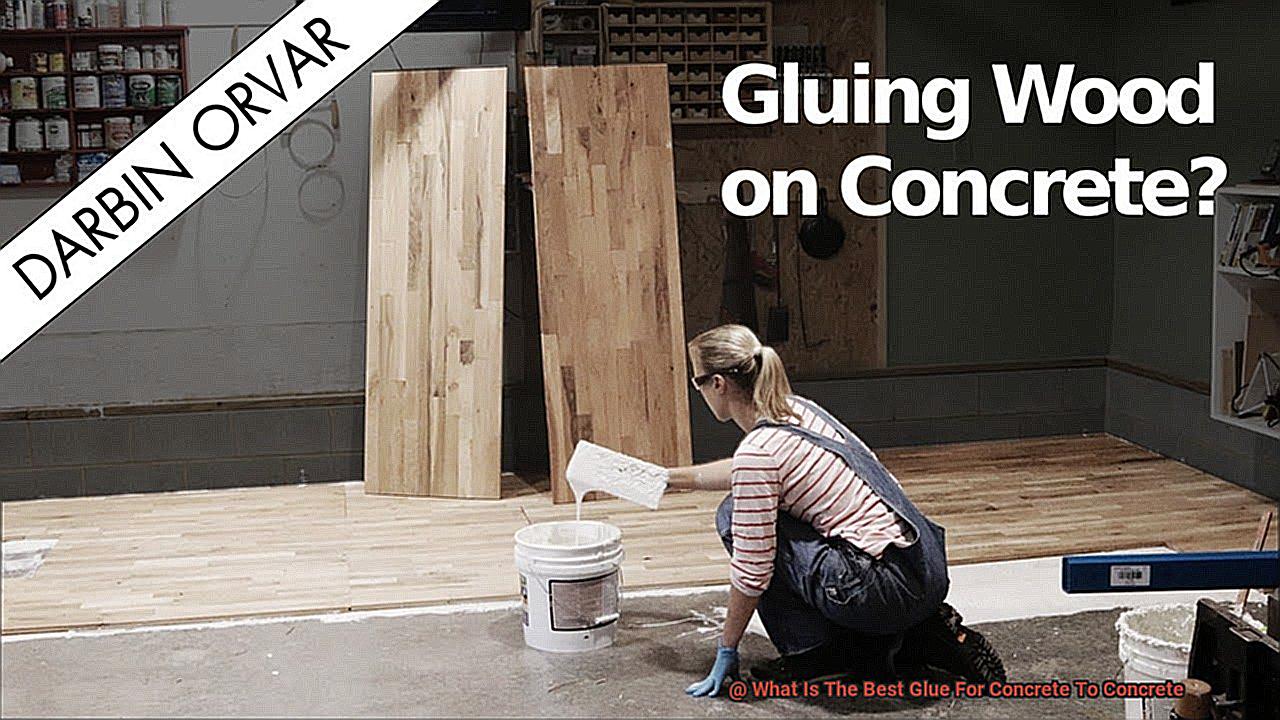
Choosing the Right Glue:
Selecting the best adhesive for your concrete bonding project requires considering various factors. These include the load-bearing capacity, environmental conditions such as temperature and moisture, and desired curing time. Consulting with a professional or referring to manufacturer guidelines is essential to ensure you choose the most suitable adhesive for your specific needs.
Why Choose the Best Glue for Concrete to Concrete?
When it comes to bonding concrete to concrete, choosing the best glue is not just a matter of convenience, but a necessity for creating a strong and long-lasting bond. Concrete is a porous material that requires a specialized adhesive to effectively penetrate its surface and create a durable connection. So, why should you invest in the best glue for concrete to concrete? Let’s explore the reasons why:
- Strength and durability: Concrete structures often bear heavy loads and vibrations. A weak bond can lead to structural failures, compromising the integrity of your project. The best glue for concrete to concrete is designed to withstand these forces, ensuring a sturdy and long-lasting bond that will hold up over time.
- Resistance to environmental factors: Concrete surfaces are exposed to various weather conditions such as extreme temperatures, humidity, and UV radiation. A high-quality adhesive will be able to withstand these elements without deteriorating or losing its bonding properties. This is particularly important for outdoor applications where the bond may be exposed to rain, snow, or direct sunlight.
- Safety: Some adhesives may contain harmful chemicals or emit strong odors during the curing process. It is essential to choose a glue that is safe to use and does not pose any health risks. Reading the product label and following the manufacturer’s instructions for proper handling and ventilation is crucial for creating a safe working environment.
- Time and cost savings: By investing in the best glue for concrete to concrete, you can save yourself time, money, and frustration in the long run. A strong and reliable bond means fewer repairs or replacements in the future, which can be costly and time-consuming.
Epoxy Adhesive: A Popular Choice for Bonding Concrete to Concrete
Epoxy adhesive is the undisputed champion when it comes to bonding concrete to concrete. Its unrivaled strength and durability make it the go-to choice for construction professionals and DIY enthusiasts alike. But what exactly makes epoxy adhesive so popular? Let’s dive into the advantages of this superhero glue.
First, let’s talk about strength. Epoxy adhesive forms a chemical bond with concrete surfaces that can withstand heavy loads and high temperatures. Whether you’re working on a construction project or fixing a cracked concrete slab, epoxy adhesive has your back.
Durability is another key advantage. It’s resistant to moisture, chemicals, and UV rays, making it suitable for indoor and outdoor applications. Say goodbye to worrying about your glued concrete falling apart after a few rain showers or exposure to harsh sunlight. Epoxy adhesive will keep your project intact for years to come.
Versatility is yet another feather in epoxy adhesive’s cap. It not only bonds concrete to concrete like a boss but also forms excellent connections with other materials like metal, wood, and ceramics. From fixing broken concrete steps to attaching metal brackets to your patio, epoxy adhesive can handle it all.
But before you embark on your epoxy adventure, remember the importance of proper surface preparation. Clean, dry, and debris-free surfaces are crucial for optimal bonding strength. Follow the manufacturer’s instructions carefully when applying the adhesive.
Polyurethane Adhesive: An Alternative Option for Bonding Concrete Surfaces
Polyurethane adhesive: An alternative option for bonding concrete surfaces
Are you tired of your concrete surfaces falling apart? Looking for a bonding solution that can withstand the toughest conditions? Look no further than polyurethane adhesive. This superhero glue is here to save the day and keep your concrete surfaces together.
Polyurethane adhesive is not your average glue. It’s known for its exceptional adhesion and durability, making it the ideal choice for bonding concrete surfaces. But what sets it apart from other types of adhesive? Let’s dive into the details.
Versatility is one of the standout features of polyurethane adhesive. It can bond various materials, including concrete, wood, metal, and plastic. So whether you’re working on a construction project or a simple DIY task, this glue has got you covered.
But its versatility is just the tip of the iceberg. Polyurethane adhesive creates a bond that is not only strong but also flexible. Unlike other adhesives, it can handle movement and vibrations without losing its grip. This makes it perfect for applications where the bonded surfaces may be subjected to stress or movement.
And that’s not all. Polyurethane adhesive boasts excellent resistance to water and chemicals, making it a reliable choice for both indoor and outdoor projects. Whether you’re waterproofing your basement or repairing concrete structures exposed to harsh substances, this glue won’t let you down.
Applying polyurethane adhesive is a breeze. Just make sure the surfaces are clean and free from any contaminants. Apply a thin and even layer onto one surface using a brush or applicator, press the second surface onto the adhesive, and apply some pressure. Voila. You’re on your way to a strong bond.
Keep in mind that polyurethane adhesive requires some curing time before it reaches its full strength. Follow the manufacturer’s instructions regarding the curing time for optimal results.
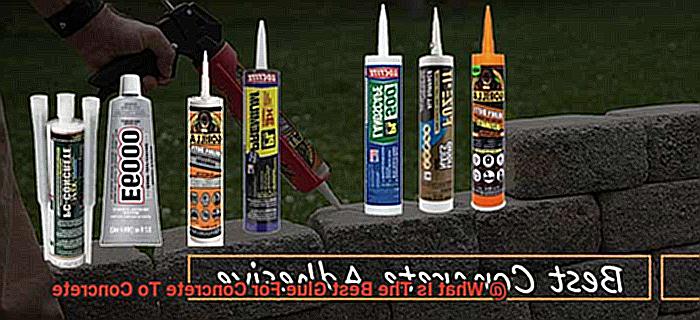
Construction Adhesive: A Heavy-Duty Glue for Bonding Concrete
I have the solution for you – construction adhesive. This heavy-duty glue is specifically designed to bond materials like concrete, making it the perfect choice for all your concrete bonding needs.
- Strength and Durability: Unlike traditional glue, construction adhesive is formulated to provide a strong and durable bond. It can withstand the weight and pressure of heavy objects, ensuring that your concrete surfaces stay securely bonded.
- Various Forms: Construction adhesive comes in liquid, paste, and foam forms. Each form has its own advantages and is suitable for different applications. Whether you need to bond large areas or fill gaps and cracks, there’s a construction adhesive that’s perfect for the job.
- Porous Material Bonding: One of the key features of construction adhesive is its ability to bond porous materials like concrete. The adhesive penetrates the surface of the concrete, creating a strong bond that is resistant to moisture and temperature changes.
- Easy Application: Applying construction adhesive is a breeze. Just follow the manufacturer’s instructions for application, which typically involve applying the adhesive evenly onto the surface and pressing the two surfaces together firmly. Make sure the surfaces are clean and free from any contaminants for a strong bond.
- Popular Brands: Some popular brands of construction adhesive commonly used for bonding concrete include Loctite PL Premium Polyurethane Construction Adhesive, SikaBond Construction Adhesive, and Gorilla Heavy Duty Construction Adhesive. These adhesives are known for their high strength and durability, making them perfect for a wide range of construction projects involving concrete.
- Versatility: Not only can construction adhesive bond concrete to concrete, but it can also be used to bond other materials to concrete, such as wood, metal, and plastic. This makes it a versatile adhesive that can be used for various applications.
It’s important to note that while construction adhesive provides a strong bond for concrete, in some cases, mechanical fasteners like screws or nails may be required in addition to the adhesive for added security.
Specialty Adhesives for Bonding Concrete to Concrete
When it comes to bonding concrete to concrete, you can’t just slap on any old glue and hope for the best. You need a specialty adhesive that is specifically designed for this purpose. Luckily, there are several options available, each with its own unique properties and advantages.
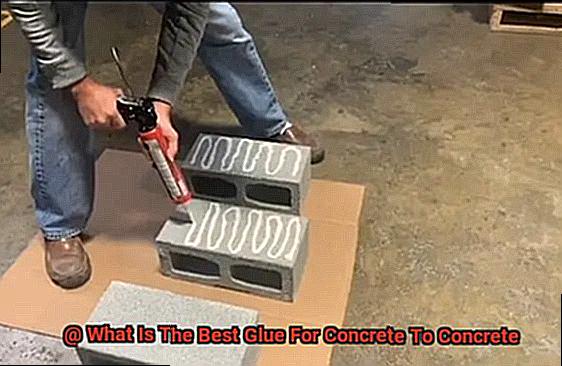
One popular choice for bonding concrete to concrete is epoxy adhesive. This adhesive packs a punch with its strong bond strength and durability. It consists of two parts – a resin and a hardener. When these two parts combine, a chemical reaction occurs, creating a bond that can withstand the test of time. Epoxy adhesives are versatile, able to bond to both porous and non-porous surfaces.
If flexibility and moisture resistance are important factors for your project, then polyurethane adhesive is the way to go. This specialty adhesive can handle both indoor and outdoor applications, making it perfect for areas that may experience movement or expansion. Not only does it have excellent adhesion properties, but it can also bond to a wide range of materials like concrete, metal, wood, and plastic.
But wait, there’s more. Acrylic adhesives are known for their lightning-fast curing time. If you’re in a hurry and need a quick bond, acrylic adhesives are your go-to choice. And let’s not forget about cyanoacrylate adhesives, also known as “super glues.” These bad boys are famous for their rapid bonding properties.
When choosing a specialty adhesive for bonding concrete to concrete, consider factors like the desired strength of the bond, application conditions (such as temperature and moisture), and specific project requirements. Always follow the manufacturer’s instructions to ensure the best results.
Factors to Consider When Choosing the Best Glue for Your Application
Choosing the best glue for your application requires careful consideration of several factors. Here are the key factors to keep in mind:
- Adhesion Strength: Look for a glue specifically designed for your application that offers high adhesion strength. This is especially important when bonding concrete, as it is a tough material that requires a strong bond.
- Drying Time: Consider the time you have available for your project and choose a glue with a drying time that matches your timeline. Avoid glues that take too long to dry or ones that dry too quickly, as they may not allow for proper positioning and adjustment.
- Application Method: Different glues come in various forms such as tubes, cartridges, brushes, or nozzles. Choose a glue with an application method that suits your needs and makes the process easier and more efficient.
- Weather Resistance: If your project will be exposed to outdoor elements, select a glue that can withstand extreme temperatures, moisture, UV rays, and other environmental factors. This will ensure that your bond remains strong even in harsh conditions.
- Flexibility: Concrete structures can experience movement over time due to temperature changes or settling. Choose a glue that offers flexibility, allowing some movement without compromising the bond between the concrete surfaces.
- Chemical Resistance: Consider if your project will come into contact with oils, solvents, or other harsh chemicals. In such cases, choose a glue that is chemically resistant to ensure its performance is not compromised.
- Ease of Cleanup: Look for a glue that is easy to clean up, whether it requires special solvents or can be easily wiped away with a damp cloth. This will help you achieve a clean and professional finish.
- Safety Precautions: Always read and follow the manufacturer’s instructions carefully to ensure safe usage of the glue. Take necessary precautions such as using proper ventilation if required or wearing protective gear.
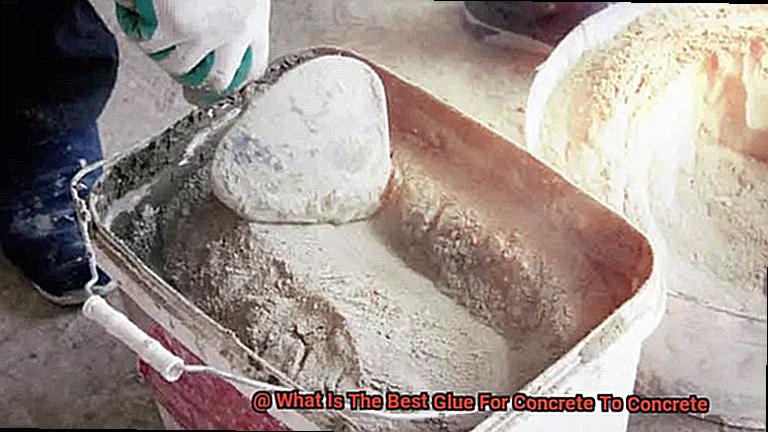
Proper Surface Preparation is Crucial for Optimal Bond Strength
In the world of concrete-to-concrete bonding, surface preparation is the secret weapon that unlocks superhero-like bond strength. Just like a trusty sidekick, proper surface preparation provides the support needed for adhesives to perform at their best. In this article, we will explore why surface preparation is crucial and provide practical tips to achieve unbeatable bond strength.
Cleanliness: The Foundation of a Solid Bond
Before any adhesive is applied, pristine surfaces are a must. Dust, dirt, oils, and grease act as villains, sabotaging adhesion and weakening bonds. To defeat them, arm yourself with a wire brush, vacuum cleaner, or pressure washer to eliminate contaminants and create a fresh canvas for bonding.
Roughness: The Heroic Texture Boost
Concrete’s smooth and non-porous nature poses a challenge for adhesives to grip onto. But fear not. By roughening the surface, you create an army of contact points for the adhesive to cling to, enhancing bond strength. Sandpaper, grinding tools, or shot blasting equipment are your allies in this battle.
The Bonding Agent: Your Superpower Booster
Sometimes, roughening alone isn’t enough. That’s when a concrete bonding agent or primer steps in as your secret weapon. These products chemically react with the concrete or add texture to create an ideal surface for adhesion. Apply a thin coat using a brush or roller and wait for it to dry before applying the adhesive.
Follow the Manufacturer’s Strategy Guide
Different adhesives have their own unique surface preparation requirements. Some may call for acid etching or specific primers. Take the time to study and follow the manufacturer’s instructions closely to ensure optimal bond strength. Don’t let ignorance be your kryptonite.
Weathering the Storm: Environmental Allies
Environmental conditions play a significant role in adhesive bonding. Stick within the recommended temperature range and avoid high humidity or extreme weather conditions during application. Adhesives have their own optimal working conditions specified by the manufacturer – heed their call.
Ccvj1sFWxw8″ >
Also Read: Does Liquid Nails Work on Concrete? – Glue Things
Conclusion
In conclusion, when it comes to finding the best glue for concrete to concrete, there are a few options that consistently rise above the rest.
One such option is epoxy adhesive, which offers exceptional bonding strength and durability. Another popular choice is polyurethane adhesive, known for its flexibility and resistance to moisture.
Additionally, construction adhesive can be a reliable solution for joining concrete surfaces together. Ultimately, the best glue for your specific project will depend on factors such as the desired strength, application method, and environmental conditions.
It’s always recommended to follow the manufacturer’s instructions and consider consulting with a professional if you’re unsure.



